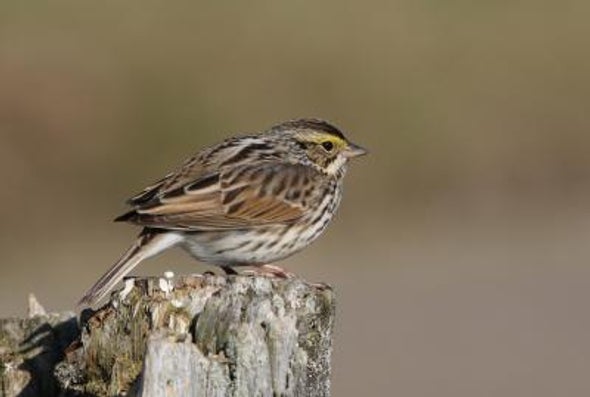(单词翻译:单击)
听力文本
This is Scientific American — 60-Second Science. I'm Jason Goldman.
Only a few kinds of animals are known to learn their vocalizations from listening to others. Us, of course. Elephants. Bats. Cetaceans—whales and dolphins. Pinnipeds—walruses, seals and sea lions. And parrots, hummingbirds and songbirds. That's it.
"When your cat meows or your dog barks, it does that because it has genetically inherited that sound. But birds are like us, young animals have to hear adults in order to develop normal sounds."
University of Windsor biologist Daniel Mennill.
There have been hundreds of conventional experiments done in laboratories with captive birds that support the idea that young birds learn to sing by listening to older birds. These studies also taught us that birds, like humans, have what's called a "sensitive period" early in life, a time when they are most disposed to learn how to vocalize from their elders.
But nobody ever did one of those experiments with wild birds. Observational studies, yes. But no true experiments. Until now, thanks to some wild savanna sparrows.
"So this population of savanna sparrows lives on an island in the Bay of Fundy in eastern North America, and it's been studied since the 1960s, so we know a lot about this population. It means we know every kind of sound that has ever been uttered by a savanna sparrow in this population over the course of many decades."

Mennill and his team installed a series of loudspeakers on the island, and they played new tunes that the sparrows would never have heard otherwise.
"The kinds of sounds that we broadcast to the animals were based on savanna sparrows, the same species, but recordings collected on the western coast of North America, many thousands of miles away from our study population."
For six years, the researchers broadcast these novel songs to five cohorts of sparrows.
"Lo and behold, this bird that arrived to breed in the spring of 2014 opened his beak and sang a song that was a perfect match with one of our stimuli."
In all, 26 birds learned their songs from loudspeakers rather than from other birds. And they had the same survival and reproductive success as all the other birds. All but one successfully mated and defended their territories. And four additional birds learned songs from birds that had originally learned from the loudspeakers.
"What we have now is a very unique, maybe a globally unique population of animals, where some of the animals sing population typical songs, that sound like other animals in their breeding population. But our experimental subjects who are living there now, are singing songs that are slightly different."
By returning to the island year after year, Mennill can study not only vocal learning, but the transmission of culture from one generation to the next. There's a lot going on in those bird brains.
Thanks for listening for Scientific American — 60-Second Science Science. I'm Jason Goldman.
参考译文
这里是科学美国人——60秒科学。我是杰森·古德曼。
目前已知只有少数几种动物通过听同伴的声音来学习发声。当然,我们人类包括在其中。另外,还有大象、蝙蝠、鲸鱼和海豚等鲸类动物,再加上海象、海豹和海狮等鳍足亚目动物,以及鹦鹉、蜂鸟和鸣禽。全部就是这些。
“你的猫喵喵叫或狗汪汪叫,是因为它们的基因遗传了这种声音。但鸟类和我们一样,幼鸟必须听成年鸟的声音来学习发出正常的叫声。”
温莎大学的生物学家丹尼尔·曼尼尔说到。
研究人员在实验室里用笼养鸟进行了数百项传统实验,结果都支持“幼鸟听老鸟唱歌来学习鸣叫”这种观点。这些研究还告诉我们,鸟类和人类一样,也会在生命早期经历一段“敏感期”,在这一时期,它们最愿意向年长同类学习发声。
但从未有人用野生鸟类做过实验。虽然有观察性研究。但没有进行过真正的实验。多亏了某些野生稀树草鹀,现在我们能用野鸟做实验了。
“这群稀树草鹀生活在北美东部芬迪湾的一座岛上,我们从上世纪60年代起就开始研究它们,所以我们非常了解这个种群。也就是说,我们知道这个稀树草鹀种群在数十年间发出的每种声音。”
曼尼尔及其团队在岛上安装了一系列扬声器,然后播放稀树草鹀从未听过的新曲调。
“我们向这些鸟儿播放的声音也是稀树草鹀的叫声,不过这些声音收录于北美西海岸,距离我们的研究种群有数千英里远。”
在6年的时间里,研究人员向5组稀树草鹀播放了这些新歌声。
“你瞧,这只在2014年春天来到这里繁殖的鸟,张开嘴唱出了一首与我们其中一个刺激物完全吻合的曲子。”
总共有26只鸟通过扬声器而不是其它鸟类学会鸣叫。它们的存活率和繁殖成功率和其它所有同类一样。除一只鸟外,所有鸟儿均成功交配并保卫了自己的领土。另外还有4只鸟从早些通过扬声器学习发声的鸟儿那里学会了鸣叫。
“现在我们拥有了一个非常独特、或许是世界独有的动物种群,有些动物唱着该种群的典型曲子,听起来就像繁殖种群里其它动物的叫声。但现在生活在岛上的这些实验对象,其所唱的曲子稍有不同。”
曼尼尔每年都会返回岛上,他不仅能研究鸟儿的鸣叫学习,还可以了解文化的代代相传。这些鸟的大脑里可是有很多东西的。
谢谢大家收听科学美国人——60秒科学。我是杰森·古德曼。
译文为可可英语翻译,未经授权请勿转载!
重点讲解
重点讲解:
1. be disposed to do sth. 乐意的;愿意的;
We passed one or two dwellings, but were not disposed to stop.
我们路过了一两个歇脚处,但却无意驻足。
2. lo and behold 你瞧;哎哟;真想不到;
He called the minister of the interior and, lo and behold, within about an hour, the prisoners were released.
他给内政部长打了个电话,结果你看,不到一个钟头囚犯就给释放了。
3. in all 总共;合计;
There were twelve of us in all for dinner.
我们一共十二人吃饭。
4. all but 除了…都;
All but one of the plates were damaged.
除去一只,盘子全打碎了。


